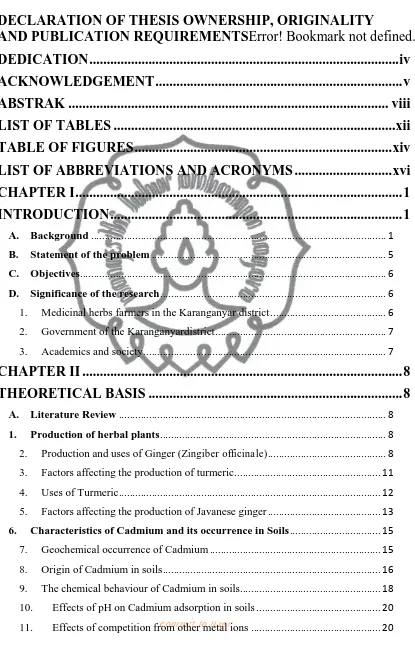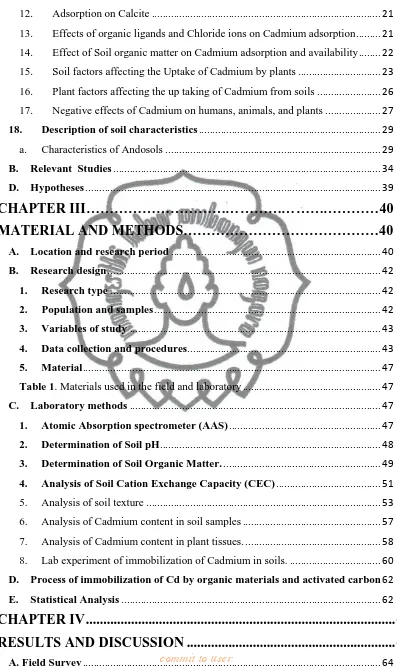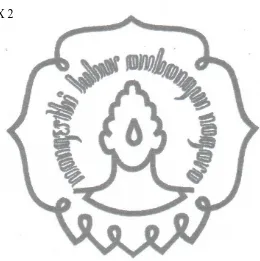commit to user
i
RESIDUAL CADMIUM CONTENT IN SOIL ANDEMPON-EMPON AND
THE EFFICIENCY OF BINDING AGENTS ON IMMOBILIZATION OF
CADMIUM IN SOIL
THESIS REPORT
Submitted in Partial Fulfillment for the Requirement of Master of Science Degree,
in Environmental Science Specialization in Natural Resources and Environmental
Management.
By
Arlindo Fernando Macie
A.131408019
ENVIRONMENTAL SCIENCE STUDY PROGRAM
SEBELAS MARET UNIVERSITY POSTGRADUATE PROGRAM
SURAKARTA
commit to user
ii
commit to user
commit to user
iv
commit to user
v
DEDICATION
First of all I dedicate these outcomes to the Almighty God for His
guidance and protection under the sun. I also thank God for boosting me with
energy and wisdom, because without Him nothing of which I have achieved
would be possible.
This thesis is dedicated to my Father, Fernando Macie and my mother
Cecília Muchanga for having brought me to the light, and for being
unconditionally supportive whenever I needed them. Special dedication I address
to my mother for her moral support every single day; she is a real champion in
person. This thesis is also dedicated to some special people in my life namely,
Wahyu, Bowen, Heitor, and my grandma Tinhala, for inspiring me on a daily
commit to user
vi
ACKNOWLEDGEMENT
I am using this rare and grand opportunity to express my gratitude to everyone who has
supported me throughout the course of this Master degree in environmental studies. I am
very grateful for the inspiring guidance and invaluably constructive criticism during the
research.
First of all, I would like to express my sincere gratitude to my advisors, Dr.
Prabang Setyono,M.Si; Dr. Ir. Widyatmani Sih Dewi,MP, and my inspiring lecturer, Mrs.
Komariah., STP., M.Sc., Ph.D for their patience, motivation, and immense knowledge. I
really admire their professionalism and high commitment.
Besides my advisors, I would like to thank the Head of Environmental Science
Department, Prof. Dr.Ir. Mth. Budiastuti, M.Si, Dr. Prabang Setyono, M.Si and Mrs. Dina
Selvia, for their readness to assist and guide whenever I needed their services. Honestly
they will never leave my heart. I am also grateful for the direction of postgraduate and the
Sebelas Maret University for the opportunity conceded in this magnificent university, as
well as their hospitality. Mrs. Tika and Diana deserve a warm thankyou for their services
and professionalism, alongside the staff of the International office, which was my first
door at Sebelas Maret University.
I owe thanks giving to my classmates Nur Aziza (from Suriname), Willie Suzuki
(from PNG), Tommy Anderson (From Madagascar), and my loved Indonesian fellows,
Mrs. (Ibu) Puji, Mr. Teguk, Mr. Hernowo, Mr. Puji, Beta Citra, Nabila (classleader),
Sulvia Dessica (Honey), Mori, Rizky, Aldo, Ayu, Denny, Inksan, Mr. Eddy, Mr. Bardi
(the humble man), Dewa, and Mrs. Naris. I am very proud of you. You all deserve the
very best and are truly irreplaceable. Alongside you I fought a good battle.
I also thank my fellow laboratory mates, Arwa and Ahzar, for each opportunity of
sharing and the togetherness which we have experienced during this restless time, and
also the staff of the Soil Science Laboratory, for their humbleness and support. They have
increased the spirit of teamwork in me, and in the meantime have helped me to more
quickly adapt to the lab environment, which is quite demanding in terms of energy and
time.
I would also wish to thank the Indonesian Government for having conceded the
scholarship, and also the Gifu University for having provided needed funds for lab
payments. I also would like to thank the biofarmaka farmers for their collaboration during
the field survey.
commit to user
vii
ABSTRACT
Arlindo Fernando Macie. A.131408019. 2016. Residual Cadmium Content in
Soil and Empon-Empon and the Efficiency of Binding Agents on
Immobilization of Cadmium in Soil. Thesis. 1
stAdvisor: Dr. Prabang
Setyono, M.Si, Lecturer at Environmental Science Department, Postgraduate
programme, Sebelas Maret University 2
ndAdvisor: Dr. Ir. Widyatmani Sih
Dewi, MP, Lecturer at Faculty of Agriculture.
Medicinal and spice herbs have been of great importance since the ancient
ages. People have relied much on them to fulfill their healthcare needs and as
ingredients of diverse cuisines. Currently, the cultivation of medicinal plants
based on agro-chemicals has posing lives because chemicals contain toxic
elements, including Cadmium. This research determined the Cd concentrations
oin soil and medicinal and spice plants, and determined the efficiency of three
binding agents on immobilization of Cd in three soil types sampled in
Karanganyar. Soil cores and rhizomes were sampled and analyzed for soil
properties and Cd content. Three soil types were incubated in triplicate. Each soil
(5 g) was treated with 0.2 g of dolomite, 1.0g of charcoal and organic fertilizer by
adding 8 ml of distilled water in a 50 ml tube, and then incubated for 24 days after
having been shaken for 16 h. were added 1ml of (HNO
3and 3 ml KClO
4to the
mixture. The mixture was first heated at 80
oC and then at 130
oC till the orange
smoke gets finished. Finally Cd was extracted with solution of 0.01 CaCl
2(20 ml),
and measured by AAS. The results showed that Cd in all the investigated villages
still below the limits (1.0 mg Cd/kg). In soils Cd ranged from 0.224 to 0.354 mg
Cd/kg, while in herbs ranged from 0.0285 to 0.0594 mg Cd/kg. Dolomite showed
the highest efficiency (95.43%) followed by organic fertilizer (92.64%) and
charcoal (91.53%) in Alfisols. In general dolomite wasthe better binding agent in
each location, while the lowest efficiency was recorded with organic fertilizer
(89.30%) in Mediterranean soils from Kemuning.
commit to user
viii
ABSTRAK
Arlindo Fernando Macie. A.131408019. 2016. Kadar Residu Kadmium dalam
Tanah dan Empom-Empon dan Effisiensi Bahan penyerap pada Imobilisasi
Kadmium dalam Tanah. Tesis. Pembimbing I: Dr. Prabang Setyono, M.Si.
Program Studi Ilmu Lingkungan, Program Pascasarjana. Pembimbing II:
Dr. Ir. Widyatmani Sih Dewi, MP. Fakultas Pertanian, Universitas Sebelas
Maret.
Obat herbal dan rempah-rempah sudah menjadi hal yang penting dari
zaman dahulu kala. Orang-orang lebih mengandalkan obat herbal dan
rempah-rempah untuk perawatan kesehatan ataupun untuk menambah cita rasa dalam
masakan. Budidaya tanaman herbal berbasis pupuk kimia telah banyak
dikembangkan, oleh karena itu, elemen-elemen toksik termasuk cadmium,
memasuki rantai makanan. Penelitian ini bertujuai mengetahui konsentrasi Cd
tanah dan tanaman herbal, serta menganalisis efisiensi yang mengikat tiga agen
imobilisasi Cd dalam tiga jenis tanah di Karanganyar. Sampel tanah dan rimpang
diteliti untuk unsur tanah dan Cd. Tiga diantaranya diinkubasi dalam rangkap tiga.
Setiap tanah (5 g) diberi pelakuan 0.2 g dolomit, 1.0 g arang dan pupuk organik
dengan menambahkan 8 ml air suling dalam tabung 50 ml, kemudian tanah
tersebut diinkubasi selama 24 hari setelah diaduk selama 16 jam. Setelah itu
tambahakan 1 ml HNO
3dan 3 ml KClO
4ke dalam campuran. Pertama panaskan
tanah pada suhu 80
○C sampai 130
○C hingga asap berwarna oranye. Kemudian Cd
diektrasi dengan larutan 0,01 CaCl
2(20 ml), lalu diukur dengan AAS. Dari hasil
penelitian menunjukan bahwa Cd dari semua desa yang diteliti masih dibawah
batas ambang (1,0 mg Cd/kg). Cadmium di tanah berkisar antara 0,224-0,354 mg
Cd/kg, sementara di jamu berkisar antara 0.0285
–
0.0594 mg Cd/kg. Dolomit
menunjukkan efisiensi tertinggi (95.43%) diikuti oleh pupuk organik (92.64%)
dan arang (91.53%) di Alfisols. Pada kesuluruan effisiensi dolomit lebih besar di
semua tanah dan lokasi, sedangkan efisiensi terendah tercatat dengan pupuk
organik (89.30%) di tanah Mediteran dari Kemuning.
commit to user
ix
CONTENT LIST
DECLARATION OF THESIS OWNERSHIP, ORIGINALITY
AND PUBLICATION REQUIREMENTSError! Bookmark not defined.
DEDICATION ... iv
ACKNOWLEDGEMENT ... v
ABSTRAK ... viii
LIST OF TABLES ... xii
TABLE OF FIGURES ... xiv
LIST OF ABBREVIATIONS AND ACRONYMS ... xvi
CHAPTER I ... 1
INTRODUCTION ... 1
A. Background ... 1
B. Statement of the problem ... 5
C. Objectives ... 6
D. Significance of the research ... 6
1. Medicinal herbs farmers in the Karanganyar district ... 6
2. Government of the Karanganyardistrict ... 7
3. Academics and society ... 7
CHAPTER II ... 8
THEORETICAL BASIS ... 8
A. Literature Review ... 8
1. Production of herbal plants ... 8
2. Production and uses of Ginger (Zingiber officinale) ... 8
3. Factors affecting the production of turmeric ... 11
4. Uses of Turmeric ... 12
5. Factors affecting the production of Javanese ginger ... 13
6. Characteristics of Cadmium and its occurrence in Soils ... 15
7. Geochemical occurrence of Cadmium ... 15
8. Origin of Cadmium in soils ... 16
9. The chemical behaviour of Cadmium in soils... 18
10. Effects of pH on Cadmium adsorption in soils ... 20
commit to user
x
12. Adsorption on Calcite ... 21
13. Effects of organic ligands and Chloride ions on Cadmium adsorption ... 21
14. Effect of Soil organic matter on Cadmium adsorption and availability ... 22
15. Soil factors affecting the Uptake of Cadmium by plants ... 23
16. Plant factors affecting the up taking of Cadmium from soils ... 26
17. Negative effects of Cadmium on humans, animals, and plants ... 27
18. Description of soil characteristics ... 29
a. Characteristics of Andosols ... 29
B. Relevant Studies ... 34
D. Hypotheses ... 39
CHAPTER III
………
40
MATERIAL AND METHODS
………
40
A. Location and research period ... 40
B. Research design ... 42
1. Research type ... 42
2. Population and samples ... 42
3. Variables of study ... 43
4. Data collection and procedures ... 43
5. Material ... 47
Table 1. Materials used in the field and laboratory ... 47
C. Laboratory methods ... 47
1. Atomic Absorption spectrometer (AAS) ... 47
2. Determination of Soil pH ... 48
3. Determination of Soil Organic Matter. ... 49
4. Analysis of Soil Cation Exchange Capacity (CEC) ... 51
5. Analysis of soil texture ... 53
6. Analysis of Cadmium content in soil samples ... 57
7. Analysis of Cadmium content in plant tissues. ... 58
8. Lab experiment of immobilization of Cadmium in soils. ... 60
D. Process of immobilization of Cd by organic materials and activated carbon 62 E. Statistical Analysis ... 62
CHAPTER IV ... 64
RESULTS AND DISCUSSION ... 64
commit to user
xi
1. Soil properties and precipitation patterns of the Study location ... 64
20. Analysis of Cadmium concentrations in soils from Karanganyar ... 67
21. Analysis of Cadmium content in rhizomes of medicinal and spice plants .... 72
22. T-Test for comparison of means of soil Characteristics and Cd in soils and herbs 74 B. Results of Pearson correlation... 81
C. Stepwise regression analysis ... 86
D. Laboratory Experiment on Immobilization of Cadmium ... 93
1. Effect of three binding agents on immobilization of cadmium in soils under medicinal plants cultivation ... 93
2. Analysis of pH of soil treated with binding agents ... 101
3. Outputs and outcomes of mitigation of Cadmium in soils ... 104
4. Adaptation strategies to Cd dynamics in plants and soil ... 108
E. Socio-economic analysis ... 110
CHAPTER V ... 119
CONCLUSION AND RECOMMENDATION ... 119
A. Conclusion... 119
B. Recommendations ... 120
APPENDIX 1 ... 127
commit to user
xii
LIST OF TABLES
Table 1. Materials used in the field and laboratory 47
Table 2. Soil Characteristics of the research sites 65
Table 3. Cadmium Concentration in Soil (mg Cd/kg) from Karanganyar 68
Table 4. Cadmium Concentration in Rhizomes 73
Table 5. Two Tailed t-Test of paired of pH Averages 75
Table 6. T-test for Averages of paired groups of Soil organic matter 76
Table 7. Two Tailed t-Test for Averages of paired groups in Soil 77
Table 8. t-Test for Averages of Paired groups of Cd in Rhizomes 78
Table 9.Table 9 t-Test for averages of paired groups of Cd averages in rhizomes of
Turmeric 79
Table 10.T-test for Averages of paired groups of Cadmium in Rhizomes of Javanese ginger 79
Table 11. t-Test for paired means of Cd in three medicinal herbs. 80
Table 12. Pearson’s correlation in Kemuning at 15 cm soil depth 82
Table 13. Pearson’s correlation in Kemuning at 30 cm soil depth 82
Table 14. Pearson’s correlation in Bakalan at 15 cm soil depth 83
Table 15. Pearson’s correlation in Bakalan at 30 cm soil depth 83
Table 16. Pearson’s correlations in Tamnsari at 15 cm soil depth 84
Table 17. Pearson’s correlations in Tamansari at 30 cm soil depth 85
Table 18. Pearson’s correlations in Sambirejo at 15 cm soil depth 85
Table 19. Pearson’s correlations in Sambirejo at 30 cm soil depth 86
Table 20. Soil properties and Cd concentration in the study location. 93
Table 21. ANOVA of Cadmium versus soil and adsorbents 94
Table22. Advanced tukey’s test for means of cadmium content in soil solution 95
Table 23. Advanced tukey’s test for means of binding agents in the soil solution 96
Table 24. Advanced Tukey’s test for Cd in soil solution versus combined factors 98
Table 25. ANOVA of pH versus soil and adsorbents 102
Table 26. Advanced tukey’s test for soil pH average 102
Table 27. Educational background 111
commit to user
xiii
Table 29. Frequency and period of fertilization 112
Table 30. Types of organic fertilizers applied 113
Table 31. Effect of organic fertilizer on yields 114
Table 32. Perception of the farmers shifting to organic farming 115
APPENDIX LIST
APPENDIX 1
127
commit to user
xiv
TABLE OF FIGURES
Figure 1. Ginger Plant 9
Figure 2. Rhizomes of Ginger 9
Figure 3. Turmeric Plant 12
Figure 4. Rhizomes of Turmeric 12
Figure 5. Dried Rhizomes 13
Figure 6. Ground Rhizomes of Turmeric 13
Figure 7. Javanese Ginger Plant 14
Figure 8. Rhizomes of Javanese Ginger 14
Figure 9. Research Location 41
Figure 10. Soil Sampling Using an Auger 45
Figure 11. Sampling Scheme (Harrell, 2014) 46
Figure 12. pH meter 49
Figure 13. Air dried Rhizomes indoor 51
Figure 14. Shaker 51
Figure 15. Analytical weighing Scale 52
Figure 16. Filtration Process and Washing with alcohol 52
Figure 17. Distillation Chamber 53
Figure 18. Heating the Solution of HCl 55
Figure 19. Heating the Solution of H2O2 55
Figure 20. Cooling of Solutions and H2O2 55
Figure 21. Reaction of H2O2 before the heating process 56
Figure 22. Filtration Process 56
Figure23. Solution with Na4P2O7 56
Figure 24. Textural Triangle 57
Figure 25. Analysis of Cadmium using AAS 59
Figure 26. Extraction of Cadmium from soil and Rhizomes 59
Figure 27. Destruction process of the samples 60
Figure 28. Cattle as a source of manure 67
commit to user
xv
Figure 30. Cadmium Concentration in Inceptisol from Kemuning 68
Figure 31. Cadmium Concentration in Alfisols from Bakalan 69
Figure 32. Cadmium Concentration in Ultisols from Tamansari 69
Figure 33. Cadmium Concentration in Ultisols from Sambirejo 70
Figure 34. Annual rainfall (Source: Department of Agriculture of Karanganyar District 71
Figure 35. Agro-forestry System 72
Figure 36. Fruit Trees combined with medicinal plants 72
Figure 37. Effects of Sand Content on Cd in Rhizomes from Kemuning 87
Figure 38. Clay Content on Cadmium in Rhizomes from Kemuning 88
Figure 39. Effect of Soil pH on Cd in Rhizomes from Kemuning 89
Figure 40. Effect of Sand and Silt Content on Cd in Rhizomes from Bakalan 90
Figure 41. Effect of Clay Content on Cd in Rhizomes from Baklan 90
Figure 42. Effect of Clay content on Cd in Soil from Tamansari 91
Figure 43. Effect of Soil Organic matter on Cd in Rhizomes from Sambirejo 92
Figure 44. Effect of Clay Content on Cd in Rhizomes from Sambirejo 92
Figure 45. Combination of Soil and Adsorbents versus Immobilized Cd 99
Figure 46. Mobile Cd in the Soil Solution versus percentage of Immobilized Cd 100
Figure 47. Cd Dynamics in Soil and plants before ammendment 107
commit to user
xvi
LIST OF ABBREVIATIONS AND ACRONYMS
ANOVA Analysis of Variance
ATP
Adenosine Triphosphate
Cd
Cadmium
CEC
Cation Exchange Capacity
DNA
Deoxyribonucleic Acid
EU
European Commission
EMPON-EMPON Medicinal and spice plants
NPK
Inorganic fertilizer containing Nitrogen Phosphorus and Potassium
SCL
Sandy Clay Loam
SL
Sandy Loam
SNI
Indonesian National Standards
SOM
Soil Organic Matter
USA
United States of America


